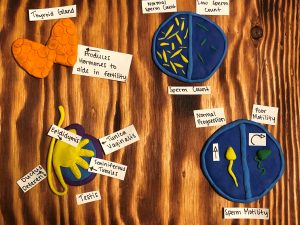My project was on infertility due to hyperthyroidism, which is the excessive production of hormones T3 and T4. This thyroid disorder, although can be easily treated, is a common factor in conception difficulty. It causes the semen and sperm to be extremely low in quality and quantity but once treated, can correct itself with time. Thyroid disorders are more commonly found in women, however, can be a main factor in male infertility.

Ashlynne’s project stems from the “Knowing the structure and function of reproductive organs†unit objective, focusing on the effects of hyperthyroidism on male fertility. Ashlynne’s art piece is two-fold; on the left side the thyroid and male reproductive organs are shown. The right side of the piece shows a comparison between sperm count and motility when the thyroid hormones, triiodothyronine (T3) and thyroxine (T4), are within their normal functioning ranges versus when T3 and T4 exceed their normal functioning ranges. The key takeaway is that high T3 and T4 values (hyperthyroidism) have the potential to diminish the sperm count and cause poor semen quality. If left untreated, hyperthyroidism may lead to infertility in males. Without the normal quantity and quality of sperm, fertilization of the oocyte does not occur, leading to conception difficulty.
I thought that this was a very interesting topic because I never knew that hyperthyroidism could cause infertility. Furthermore, it was a good reminder that males also suffer from thyroid disorders, as I have previously been told that it is a woman’s disease — not true! I also liked the way that Ashlynne depicted the topic, it is very clear and to the point. Nice job.